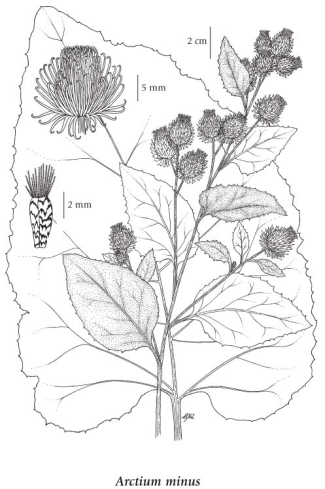Arctium minus Bernh.
common burdock (lesser burdock)
Asteraceae (Aster family)
Introduction to Vascular Plants
common burdock (lesser burdock)
Asteraceae (Aster family)
Introduction to Vascular Plants
Species Information
General:
Large, coarse, biennial herb; stems erect, leafy, 0.5-1.5 m tall.
Leaves:
Basal leaves large, up to 60 cm long and 40 cm wide, egg- to heart-shaped, short-stalked or unstalked (the lower stalks hollow), green and nearly glabrous above, thinly white-woolly beneath; stem leaves similar, alternate, progressively reduced upwards.
Flowers:
Heads numerous in a relatively scattered, elongate inflorescence; involucres globose, burlike, 1.5-2.5, rarely 3.5 cm wide, nearly unstalked or on short stalks; involucral bracts in several series, long, narrow, angled, ascending with inwardly hooked tips; ray flowers lacking; disk flowers deep pink to purple, tubular.
Fruits:
Achenes glabrous, oblong, 3-angled, several-ribbed; pappus of numerous short bristles.
Illustration

If more than one illustration is available for a species (e.g., separate illustrations were provided for two subspecies) then links to the separate images will be provided below. Note that individual subspecies or varietal illustrations are not always available.
Illustration Source: The Illustrated Flora of British Columbia
Ecology
Ecological Framework for Arctium minus
The table below shows the species-specific information calculated from
original data (BEC database) provided by the BC Ministry of Forests and Range.
(Updated August, 2013)
The table below shows the species-specific information calculated from
original data (BEC database) provided by the BC Ministry of Forests and Range.
(Updated August, 2013)
| Site Information |
Value / Class |
||
|
Avg |
Min |
Max |
|
| Elevation
(metres) |
554 | 35 | 930 |
| Slope
Gradient (%) |
6 | 0 | 40 |
|
Aspect (degrees) |
185 | 35 | 290 |
| Soil
Moisture Regime (SMR) [0 - very xeric; 4 - mesic; 8 - hydric] |
5 | 5 | 7 |
| Modal
Nutrient Regime
Class |
D | ||
| #
of field plots species was recorded in: |
40 | ||
| Modal
BEC Zone Class |
BG | ||
|
All BEC Zones (# of stations/zone) species was recorded in |
BG(19), CWH(7), IDF(9), PP(1) | ||
|
Source:
Klinkenberg 2013
|
|||
Habitat and Range
Dry roadsides, disturbed areas and pastures in the lowland, steppe and montane zones; frequent in coastal, WC and S BC; introduced from Eurasia. DescriptionStatus Information
Synonyms
Synonyms and Alternate Names:
Lappa minor Hill